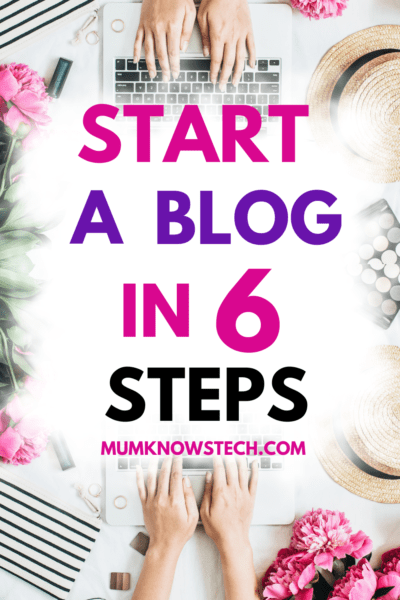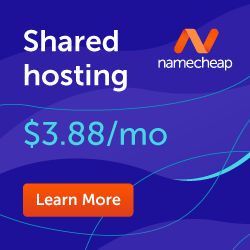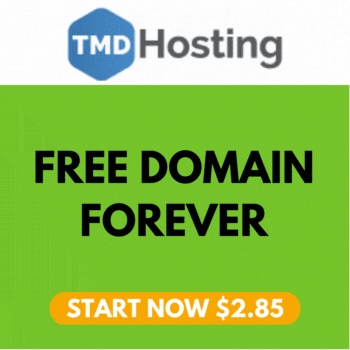How To Start A Blog In 6 Steps

Starting a blog is a great way to express yourself and potentially earn some extra income. Here are the top 6 steps to getting your blog up and running:
1. Choose A Niche For Your Blog
Before you start a blog, you need to choose a niche. Your niche is the specific topic or theme that your blog will focus on.
Choosing a niche you are passionate about or knowledgeable in will make writing and maintaining your blog easier.
Having a specific niche will help you target a specific audience and establish yourself as an expert.
When choosing your niche, consider your interests and experiences, and any unique skills or knowledge you may have.
It's also a good idea to research the demand for your chosen niche and the potential audience for your content. This research can be done by using Google Trends or Google’s Keyword Planner.
2. Choose a Domain Name & Web Hosting Provider
When you're ready to start your blog, it's time to choose a domain name and web host.
Your domain name is your blog's address on the internet (example: yourblog.com).
When picking a domain name, try to choose something short, memorable, and relevant to your blog's subject matter.
I recommend a .com domain because it is more widely recognized and trusted.
Web Hosting is where you store the content and files of your blog. There are many options available ranging from free to paid.
If your intention for blogging is to scale and make a regular income stream, I recommend shared web hosting.
Here are a few of the reasons why shared web hosting is a better choice than website builders:
Ownership and Control
With shared hosting, you own your website and have complete control over it.
This means you can customize it however you like, install any software or scripts, and make any changes you want.
With a website builder, your website design and functionality may be limited by the options and templates they provide.
Flexibility and Scalability
Shared hosting gives you more flexibility and scalability than a website builder.
There's a wide range of hosting providers and plans, and you can easily upgrade your plan as your website grows.
A website builder may limit the options and features. It may also be more difficult and expensive to scale your website, if you outgrow the capabilities of the builder.
Multiple Websites
Some shared hosting plans offer unlimited websites for just a few extra dollars per month. The only extra you would have to pay is for each domain name.
Having the ability to host multiple websites can be useful for expanding your brand and potentially generating income.
It's common to have multiple website ideas and hosting multiple websites through a single plan can be very convenient.
You can also host websites for your family, friends and clients.”
One-click installations such as Softaculous
Softaculous allows you to easily install software or scripts with just a few clicks.
You can choose from a wide range of software and scripts, including popular CMS like WordPress, Joomla, and Drupal.
Simply select the software you want to install, enter your desired settings, and click “INSTALL”.
Softaculous will handle the rest, installing and configuring the software for you.
One-click installations can save you time and effort and make it easier to get your website up and running quickly.
Overall, shared web hosting can be a better choice than a website builder if you want more ownership and control over your website, more flexibility and scalability, and better resources, performance and security.
The Top 3 Shared Web Hosting providers for 2023 are:
In a recent article called the Top 10 Shared Website Hosting 2023, I found these 3 Web Hosts to have the best features for the best price in the following categories:
Intermediate Plan Winner:

Advanced Plan Winner:

Advanced & Extra Plan Winner:

3. Choose A CMS (Content Management System)
Before you start your blog, it's a good idea to choose a CMS for your website.
WordPress and Joomla are two of the most popular CMS) available. Both offer a range of features and capabilities for creating and managing websites, but there are some key differences.
WordPress is known for its ease of use and wide range of templates and plugins, making it a popular choice for beginners and professionals. It is highly customizable and can be used to build a variety of websites, including personal, business, and e-commerce websites. WordPress powers around 30% of all websites on the internet.
Joomla is a more powerful and flexible CMS, offering a range of advanced features and capabilities. It is suitable for building complex websites and online applications, and is often used by large organizations and enterprises. Joomla is less user-friendly than WordPress, and may require a little more technical expertise to set up and use.
GET MY FREE EBOOK: DIY WORDPRESS WEBSITE – A STEP-BY-STEP GUIDE.4. Design Your Blog
WordPress offers a wide range of free and paid themes to easily customize the appearance of your website.
Themes control the layout and design of your website, and can be easily installed and activated from the WordPress dashboard.
Free themes are a good choice for those who are just starting out or on a tight budget.
Paid themes often offer more advanced features and customization options.
It's important to choose a responsive and mobile-friendly theme, as more people are accessing the internet from their smartphones.
You can find free images for your blog on sites like pxhere.com and rawpixels.com.
Canva is an excellent website for creating and editing all types of images, documents and videos. It’s especially helpful for designing your website logos, banners and images, as well as creating videos and social media posts.
Canva has an app for Mac, PC, Ipad and Mobile so you can access your designs on all your devices.
Canva offers both a free and paid plan.
For a 30 Day FREE TRIAL of Canva‘s Pro plan click the image below.

Read my Canva article called YOUR ALL-IN-ONE DESIGN SOLUTION to learn about all the amazing things you can create with Canva.
5. Create a Strategy For Your Blog Content
Before you start posting on your blog, it's important to have a plan in place.
Decide on the topics you want to cover, the frequency of your posts, and any details that will help you stay organized and consistent.
It can also be helpful to create an editorial calendar to keep track of your content ideas and schedule.
It's important to find a balance between writing about what you love and what your audience wants to read, and to mix up your content with different formats such as text, images, and videos.
Setting goals for your blog and tracking your progress can help you determine what is working well and what can be improved.
6. Monetizing Your Blog
After you start your blog and write a few posts, it's time to monetize your blog.
There are many ways to monetize a blog, and the best approach will depend on your goals and audience. Some common ways to monetize a blog include:
- Advertising: You can display ads on your blog and earn money based on the number of clicks or impressions they receive. This can be done through a network like Google AdSense, or by directly selling ad space to companies. Read my article How To Make Money With Google Adsense
- Affiliate marketing: You can promote products or services from other companies on your blog and earn a commission when someone clicks on your affiliate link and makes a purchase. Read my article How Affiliate Marketing Works Step By Step
- Sponsored content: You can work with brands to create sponsored content, where you write a blog post or create other content that promotes the brand's products or services. You can charge the brand a fee for this content, or receive a commission based on any sales generated.
- Selling products or services: You can sell your own products or services on your blog, such as digital products like eBooks or courses, or physical products like handmade crafts or apparel.
It's important to find a monetization strategy that aligns with your goals and values, and won't turn your audience off.
Experiment with different monetization options and see what works best for you.
In conclusion, it is easier to start a blog than most people think, and it can be a rewarding and fulfilling experience that allows you to share your ideas, thoughts, and experiences with the world.
By taking the time to plan and prepare, you can create a blog that is both enjoyable to maintain and successful in achieving your goals.
Whether you want to express yourself, share your knowledge, or earn some extra income, a blog can be a great platform for achieving your goals.
